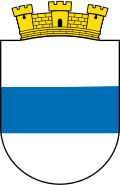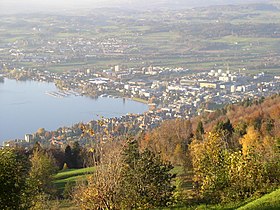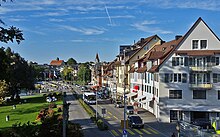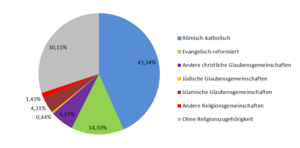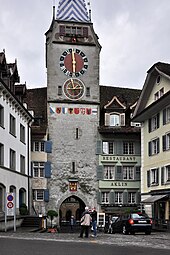Train (city)
| train | |
|---|---|
| State : |
|
| Canton : |
|
| District : | No district division |
| BFS no. : | 1711 |
| Postal code : |
6300–6305 (Zug) 6317 (Oberwil b. Zug) |
| UN / LOCODE : | CH ZLM |
| Coordinates : | 681 646 / 224 472 |
| Height : | 425 m above sea level M. |
| Height range : | 410–1579 m above sea level M. |
| Area : | 21.62 km² |
| Residents: | 30,542 (December 31, 2018) |
| Population density : | 1413 inhabitants per km² |
|
Proportion of foreigners : (residents without citizenship ) |
32.7% (December 31, 2,015) |
| City President : | Karl Kobelt ( FDP ) |
| Website: | www.stadtzug.ch |
|
View from Zugerberg to Zug |
|
| Location of the municipality | |
Zug ( Swiss German Zùùg [tsʊːɡ̊] , French Zoug, Italian Zugo, Rhaeto-Romanic , Latin Tugium ) is a political municipality and capital of the Swiss canton of Zug .
geography
location
Zug is 425 m above sea level. M. am Zugersee , embedded between the northeastern bank of the Zugersee and the foot and the lower western slopes of the Zugerberg , in central Switzerland , in the Swiss plateau . The city of Zug is 23 km south of Zurich (as the crow flies).
Land use
The area of the 33.8 km² municipal area comprises a section on the north-eastern shore of Lake Zug, at the transition from the Swiss plateau to the pre-alpine hilly landscape. Of these 34 km², a little more than 12 km² are on Lake Zug. The lakeshore length of Zug is about 11 km and extends from the bay east of Cham to the Lotenbach near Walchwil. In 1997, the land share of Zug's municipal area consisted of 23.8% settlement area, 35.5% agricultural area, 38.1% forest and woodland and 2.6% unproductive area.
Waters
Along the northern shore of Lake Zug, the area comprises an approximately 1 km wide strip of the Lorzen Plain (also called Baar Plain), which is 420 m above sea level on average . M. lies. After the last Ice Age, this alluvial plain was filled up by erosion material that was carried along by the Lorze from the upper catchment area. Three watercourses flow from this plain into the lake, namely from west to east the Steinhauser Dorfbach (which also forms the western boundary of the municipality), the Alte Lorze and the canalized Lorze . The lower Lorzelauf was corrected in 1976 and relocated to the east by more than 1 km. While the former mouth of the Lorze is characterized by an alluvial cone that protrudes into the lake at the Kollermühle, the straightened river flows into Lake Zug at the Brüggli recreation area.
geology
The eastern and southern parts of the municipality are occupied by the Zugerberg, which geologically consists of unfolded layers of the subalpine molasse . This pre-alpine ridge, which in the Hünggigütsch at 1039 m above sea level. M. peaks, has in its ridge area a high plateau with a width of up to 2 km. Between the moraines of the Reuss Glacier from the Würme Ice Age , the Eigenried moor was created here (mostly in the Walchwil area), which is one of the most valuable nature reserves in the canton of Zug. To the west, the Zugerberg falls steeply towards Lake Zug, only the foot of the slope shows a gentler slope in the area of the city of Zug. The slope consists of extensive mixed beech forests and is subdivided by the erosion channels of a series of short streams, including the Bohlbach, the Mülibach and the Lotenbach . A small portion of the community area is on the eastern slope of the Zugerberg in the catchment area of the upper Lorze.
The city of Zug also has an exclave of around 1 km² called Alpli on the northern slope of the Rossberg . It encompasses a Karmulde with alpine mountain pastures, which lies between the summits of the Gnipen ( 1567 m above sea level ) and Wildspitz (at 1580 m above sea level, the highest elevation in the municipality) and is drained from the Alplibach over the Hüribach to the Ägerisee .
Urban areas and neighboring communities
The city of Zug includes extensive commercial, industrial and residential quarters in the Lorzen Plain, and the Lorzen, Kollermühle, Steinhuserbrugg and Ammannsmatt settlements somewhat separated from the actual city area . Also part of the city are the village of Oberwil , the settlement of Räbmatt , both south of Zug on the lakeshore, as well as various farm settlements at the height of the Zugerberg. The neighboring communities of Zug are Cham and Steinhausen in the north-west, Baar in the north, Unterägeri in the east, Walchwil in the south and Meierskappel and Risch in the west (pure sea border) . Zug has already grown together strongly with the municipalities of Baar, Steinhausen and Cham, which are also located in the Lorzen Plain. Especially between Zug and Baar, this process has progressed so far that the municipal boundaries are barely noticeable. In addition, Zug and its exclave share borders with the Schwyz municipalities of Arth and Steinerberg .
history
Surname
The name Zug comes from the Old High German generic word zug ‹pulling, pulling, (fish) catching, pulling in the fishing nets›. Already in Middle High German, the word became a legal term, ie ‹fishing justice, fishing›, and a locality concept, meaning ‹place, place, part of the water where you are allowed to fish›. The generic word designating the place was gradually transferred to the fishing settlement there and thus secondary to the place name. In the case of today's city of Zug, there is probably a name from the perspective of the much older town of Cham .
The Latin name Tugium was invented in the 16th century by the humanist Glarean , who tried to trace the city name back to antiquity and the Helvetian tribe of the Tugins mentioned by Strabo . Archaeological finds in the area of the city of Zug indicate a Roman settlement that cannot be precisely located. However, their name is unknown.
City foundation
At the beginning of the 13th century, the Counts of Kyburg , who ruled over the area of Zug since the Lenzburgs died out in 1173, may have founded the city of Zug on the shores of Lake Zug. Up the hill from the city were older settlement centers, namely the parish church of St. Michael, Zug Castle and a village of the same name.
For a long time, the motive for founding the city was the convenient location on the trade route from Zurich to northern Italy over the Gotthard , which should lead over Lake Zug to Immensee, from there to Küssnacht and on over Lake Lucerne . However, this assumption can no longer be maintained today. On the other hand, the fact that Zug was only later equipped with the customs privilege between 1303 and 1326 and the orientation of Zurich in trade in Italy to the more favorably located Bünder Passes speak against it.
In its first phase of development, the city consisted of only a part of today's old town, which, however, had another, no longer existing third alley below today's Untergasse. Today's Untergasse was thus still the Mittelgasse until the old town disaster in 1435. The urban area therefore consisted of six roughly parallel rows of houses running southwards.
In a document mentioning it in 1242, Zug was first referred to as oppidum (Latin for “town, small town”), and in 1255 as castrum (Latin for “fixed place, castle”). The Liebfrauenkapelle was first mentioned in a document in 1266.
To the north of the old town there was a suburban settlement on the lake shore, today's suburb. Archaeological finds and historical sources have documented the artisan settlement called Stad with private Susten and a berth for boats since the 14th century at the latest.
Train under Habsburg rule
In 1273 , a few months before he was elected German king , Rudolf von Habsburg bought , in addition to large parts of formerly Kyburg and Laufenburg property, the city of Zug and Arth am See from the Kyburg heir daughter Anna. The Habsburgs now merged Zug and the surrounding settlements to form the Zug office .
The Habsburgs massively expanded Zug's city fortifications. The simple passage gate was attached to the Zitturm in the late 13th century or around 1300. The Lughaus next to the Zitturm was built as a flanking and customs house. The curtain wall was reinforced all around with a fence wall, which was protected on the outside with a second city moat. The construction of the kennel wall could be dated between 1326 and 1370. Older research erroneously interpreted the Zwingermauer as an expansion of the city after 1435 or 1478.
In 1315, Zug is said to have served the Habsburg troops under Duke Leopold I as a collection point for the Battle of Morgarten . After the defeat of the Habsburgs, Zug remained Habsburg, but after the alliance of Lucerne with the Confederation in 1332 and Zurich's entry into the Confederation on May 1, 1351, Zug was finally completely surrounded by federal territory. On June 8, 1352, the Confederates besieged the city of Zug after the surrounding area had not offered any resistance. When Duke Albrecht did not want to send any help, the city was handed over. Zug then joined the Confederation of Confederation on June 27, 1352 , together with his external office consisting of Ägeri, Menzingen and Baar. The so-called Zugerbund did not change much of the ruling situation , because it did not mean the dissolution of the Habsburg rule over Zug, but rather the Zugers continued to undertake to recognize the Habsburg courts and to pay the levies raised.
After the second siege of Zurich by Duke Albrecht, through the mediation of Margrave Ludwig of Brandenburg between the conflicting parties on September 1, 1352, the peace agreement named after him came about, which recognizes the federal alliances, but withholds the Zugerbund and thus implies its illegality. For Zug, this continued to mean Habsburg rule. Habsburg provided the ammen of Zug and Rudolf IV granted the city the right of sust and customs on August 21, 1359 .
Presumably in the late summer of 1365, the Schwyzer conquered the city of Zug for the second time together with some from the Aegerital, but without the support of other federal locations. From then on Schwyz provided the Zuger Ammann, documented between 1370 and 1404. However, the taxes to be paid still went to Habsburg.
On June 24th, 1400 King Wenzel granted the city of Zug the high level of jurisdiction , the ban of blood, over city and office. Because of this, the banner and seal trade started in 1404, in which the Foreign Office demanded the surrender of banners, seals and certificates to compensate.
Zug's independence

In the 14th and 15th centuries, the city of Zug increasingly acquired bailiwicks around Lake Zug, including Cham, Steinhausen, Hünenberg, Risch and Walchwil. With the granting of imperial freedom by King Sigismund in 1415, Zug became independent and all Habsburg claims were extinguished.
On March 4, 1435, the then Untergasse sank together with the houses on the lake in Lake Zug . 60 people were killed and 26 houses were destroyed.
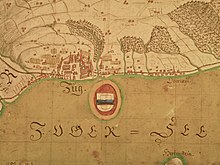
From 1478 the city had the builder Hans Felder build the church of St. Oswald and expanded its urban area many times over. The plan of the new city fortifications and the construction of the Neugasse follow an absolutely regular floor plan, derived from a circle, with the center at Kolinplatz, where all traffic routes meet. This city map is related to ideal cities of the Italian Renaissance. In 1505 the city had the town hall built, in 1516 a hospital (today Burgbachschulhaus) and in 1530 a granary (today library). From 1518 to 1536 the new city fortifications with the characteristic cylinder towers were completed.
Zug decided to remain Catholic during the Reformation in 1526 and formed the Golden Bund with Uri , Schwyz , Unterwalden , Freiburg and Solothurn on October 5, 1586 . With the Capuchin monastery of 1595, the first municipal settlement came about.
The following years were marked by tensions between the city of Zug and the Foreign Office, which fought over competencies and participation. After various federal arbitration awards, the Libell Treaty (from Latin libellus ‹booklet›) came about in 1604 , which for the first time regulated the relationship between city and office in writing and formed the basis of public law until Zug was occupied by the French in 1798 . Even if the city continued to be the central location of political events, the Libell Treaty put the city and the office on an equal footing and gave the state a say in all decisions.
During the Napoleonic campaigns , Zug was assigned to the canton of Waldstätte as part of the Helvetic Republic , and it was its capital from 1799 to 1802.
After the collapse of the Helvetic Republic, Zug became the capital of the canton through the first constitution of the canton of Zug in 1814.
The years from 1830 to 1847 were marked by political conflicts between conservatives and liberals. Zug, which had joined the Sonderbund and thus fought on the Catholic side in the Sonderbund War, had to capitulate on November 22, 1847, was occupied by federal troops and obliged to pay reparations .

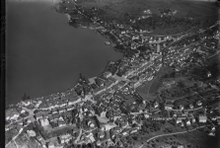
During the so-called “suburban catastrophe ” on July 5, 1887 , a bank break-in destroyed 35 buildings in the suburb, cost the lives of 11 people and left 650 people homeless. The houses slipped after piles and backfills during construction work on a new quay, which weakened the bank's stability and led to a load-bearing layer of muddy sand slipping away. In order to reduce the stress on the shore zone, 15 houses next to the government building were demolished and replaced by a green area.
On September 27, 2001, an attack, the Zug assassination attempt , was carried out on the Zug parliament, in which 14 politicians were killed and many others were injured.
coat of arms
The city arms of Zug consist of a white shield, which is divided horizontally in the middle by a blue bar and crowned by a yellow castle wall. The castle wall was only introduced at the beginning of the 20th century to better distinguish it from the coat of arms of the canton of Zug, which also differs in color from the city coat of arms. The coat of arms points back to the time of the Habsburgs , who officially ruled over the area of the city of Zug until June 27, 1352 and whose shield only differed from the Zug city arms in the red color of the horizontal bar.
population
With 30,000 inhabitants, Zug is the largest city in the canton of Zug (as of the end of September 2017). Especially in the years around 1900 and from 1950 to 1970 the population of Zug increased significantly. After 1970, when the first peak was recorded with around 23,000 inhabitants, there was a kink in the demographic development. During the 1970s, the population decreased by almost 6%. After that, the number of inhabitants remained at a constant level before continuous growth began again at the beginning of the 1990s due to heavy building activity. New single and multi-family houses have been built in recent years mainly on the slopes of the Zugerberg and in the Lorze plain north of the city center. The settlement area of Zug has largely grown together with that of Baar . In the Lorze Plain, however, there are still larger open spaces between the settlement and commercial areas that serve as building land reserves.
The proportion of the foreign population is 32.7%, above the cantonal average of 27%. In the 2000 census, 81.8% stated German as their main language, followed by Italian with 3.8% and Bosnian / Croatian / Serbian with 3.2%.
The most strongly represented religious community in the city of Zug is the Roman Catholic. According to the sample survey in 2018, 43.34% of the residents were Catholic, 14.10% Protestant Reformed, 12.45% belonged to other faiths and 30.11% were non-denominational. In comparison, in 2011 48.37% of the residents were Catholics, 15.09% Protestants, 14.18% belonged to other faiths and 22.36% were non-denominational.
| Population development | |||||||||||||||
|---|---|---|---|---|---|---|---|---|---|---|---|---|---|---|---|
| year | 1850 | 1880 | 1900 | 1910 | 1920 | 1930 | 1941 | 1950 | 1960 | 1970 | 1980 | 1990 | 2000 | 2010 | 2015 |
| Residents | 3,302 | 4,805 | 6,508 | 8,096 | 9,499 | 11,113 | 12,372 | 14,488 | 19,729 | 22,972 | 21,609 | 21,705 | 22,973 | 25,726 | 29'251 |
politics
legislative branch
The city council has been the legislative body of the city of Zug since February 1st, 1963 . He replaced the previously existing municipal assembly as the legislature. The large municipal council consists of the council president, his vice-president and 38 councilors and is elected by the town's voters on a proportional basis for a period of four years. The municipal council president, vice president and two tellers are elected by the municipal council itself for a period of two years. Its powers are laid down in the municipal code of the city of Zug dated February 1, 2005. As a rule, it meets once a month in the cantonal council chamber of the government building for public meetings. The current president of the municipal council is Bruno Zimmermann (SVP).
The distribution of seats in the large municipal council is as follows:
| Political party | FDP | Greens / CSP | SVP | CVP | SP | glp |
| 2018 | 10 seats | 7 seats | 8 seats | 6 seats | 6 seats | 3 seats |
| 2014 | 10 seats | 7 seats | 7 seats | 7 seats | 6 seats | 2 seats |
| 2010 | 10 seats | 8 seats | 8 seats | 7 seats | 5 seats | 2 seats |
executive

The city council is the executive authority of the city of Zug and consists of the city president , the vice president, three other city councilors and a city clerk. The city council is elected every four years by proportional representation. The mayor is determined by majority vote . He takes over the management, the supervision of the city administration and represents the community to the outside world. He meets weekly in the town hall of the town hall. The current city president is Karl Kobelt (FDP). The individual city councils are each responsible for a specific administrative department (department). The distribution of tasks is as follows:
| Surname | Political party | function | Administrative department |
|---|---|---|---|
| Karl Kobelt | FDP | City President | Presidential Department |
| Eliane Birchmeier | FDP | Councilor | Building department |
| Urs Raschle | CVP | City council | Department of Social Affairs, Environment and Security |
| Vroni Straub-Müller | CSP | City Councilor / Vice President | Education Department |
| André Wicki | SVP | City council | Finance Department |
| Martin Würmli | CVP | Town clerk | - |
Cantonal elections
In the 2018 cantonal elections in the canton of Zug, the share of the vote in Zug was: FDP 24.9%, SVP 19.7%, Greens / CSP 16.2%, SP 16.0%, CVP 15.7%, glp 7.5% .
National Council elections
In the Swiss parliamentary elections in 2019 , voters in shares amounted to train: Green 23.5%, SVP 20.6%, CVP 18.4%, FDP 18.4%, SP 12.7%, glp 5.7%.
economy
The canton of Zug, which is known as Switzerland's tax haven , has the lowest tax rates in the country; they are roughly half the Swiss average. For this reason, many multinational companies that are primarily active in raw materials trading ( Glencore ) and in the financial sector have their administrative headquarters in the city of Zug, such as the BASF subsidiaries Wintershall and Intertrade AG . There are also a large number of holding companies, domiciliary companies - better known as letterbox companies - and fiduciary offices in Zug. Companies from the sports sector are also in Zug, from FIFA to the former professional tennis player Boris Becker . However, the low taxes are offset by the high cost of living . There are around 24,000 jobs and around 12,000 registered companies for every 30,000 inhabitants in the city. The Siemens Building ( Siemens Building Technologies ) is of 1900 employees the largest employer in train. The second largest employer is the canton of Zug, which employs around 1,600 people in the cantonal administration. Other major employers in the city are V-Zug AG , the city administration , Zuger Kantonalbank , Coop Zentralschweiz-Zürich, Unilever and the Argo-Hytos Group .
The Lohri House is considered the oldest goldsmith's house in Europe, where goldsmiths still work.
traffic
The city is conveniently located on the Zug – Lucerne and Zurich – Gotthard railway lines . With the InterRegio , Zurich or Lucerne can be reached in 25 minutes. The A4a motorway section connects Zug with the A4 ( Bargen - Altdorf ), it is linked to the A14 ( Holzhäusern - Lucerne). The journey time to the nearest airport, Zurich-Kloten, is around 40 minutes by car.
Zug is connected to the Zurich S-Bahn network and has a dense public transport network . The station square of the train station in Zug , which opened on November 28, 2003, is a central hub in the transport network of the Zugerland Verkehrsbetriebe (ZVB), which has 285 stops and a total route length of 197 km. Since December 12, 2004, the Zug urban railway has been providing even better access to regional transport. The tram consists of Line 1, which runs between Baar and Lucerne, and Line 2 from Zug via Walchwil to Erstfeld . There are a total of seven SBB train stations and stops in the city.
The Zugersee Schifffahrt enables you to travel on the Zugersee between April and October . The fleet, which consists of four ships, heads for all the larger towns on the lake and transports between 130,000 and 150,000 people annually. - On the Zugerberg driving Zugerbergbahn (ZBB) from the valley station Schönegg. This funicular can be reached by bus line 11 from the train station. The mountain railway takes you to 926 m above sea level in around 6 minutes . M. and transports around 300,000 people per year.
Attractions
The 52 meter high Zytturm in the old town is the landmark of Zug. It was built in the middle of the 13th century as a simple passage on an area of 5.8 m by 6.3 m in the oldest wall ring and was raised by Hans Felder from 1478 to 1480 and with a pent roof sloping towards the city with central turrets, side battlements and a simple clock. In 1557 the roof of the Zytturm was given the shape it still has today, with a guardroom, tower-shaped bay windows and a steep hipped roof painted in the city colors; 1574 the big clock and the astronomical dial on the side facing the Kolinplatz. Until the construction of the second curtain wall, the tower served as a lockable entrance to the city. However, it was also used as a prison and guard room for fires.
Interesting buildings from the 16th and 17th centuries stand on Kolinplatz: the Kolinbrunnen (1541), the town house (also called Bossardhaus) (1543), and the Kolinhaus (1665).
The four-storey town hall of Zug , built by the master builder Heinrich Sutter from 1505 to 1509, is an important secular architectural monument of the late Gothic period in Switzerland. The building with a stepped gable is located in the old town on the corner of the street between the fish market and the Unter-Altstadt, despite the city expansion that was carried out before construction began. The ground floor was previously used as a market hall. The first and second floors were changed as needed for the council and court and the top floor served as the council chamber. Today the town hall is used by its owner, the community as a chancellery, for the citizens' council and for community assemblies. The Gothic Hall on the top floor serves as a location for exhibitions and other cultural events.
The construction of the late Gothic church of St. Oswald began on May 18, 1478 under the direction of the south German master builder Hans Felder the Elder. The single-nave church, which was completed after five years, was expanded into a three-nave basilica in the middle of the 16th century. In the period from 1760 to 1765 the church was given a baroque organ by the organ builder Viktor Ferdinand Bossard. Karl Albert Keizer adapted the church to the neo-Gothic style between 1860 and 1870 . The high altar was created by the sculptor Otto Glänz from Freiburg im Breisgau .
In the cemetery chapel, the former ossuary of St. Michael, there is a large-format mural with the motif of the "grateful dead" from around 1549. This fresco, which has only survived in fragments, is largely identical in composition and design to the mural on the outside wall of the former ossuary in Baar / Canton Zug. The knight kneeling in front of the ossuary is protected from his persecutors by the dead because he has prayed for the deceased all his life. The dead come from the open graves and arm themselves with the handicraft tools used in life. Originally the prayer texts of the knight were to be read on the large white areas of the picture. From 1926 to 1927, the church painter Fritz Kunz created the paintings Nativity and Ascension for the church .
The Theater Casino Zug was built from 1907 to 1909 according to plans by Zug architects Dagobert Keizer and Richard Bracher in neo-baroque style after the city theater of the Zug Theater and Music Society on Postplatz had to be closed due to dilapidation. It is located on Grabenstrasse above the Seelikon bathing area directly on Lake Zug and has a spacious terrace on the lake side. The theater hall, which had difficult acoustics for spoken theater, could no longer meet the requirements in the 1950s. After initial demolition requests and subsequent new construction, the building was completely restored between 1979 and 1981 according to the plans of the architects Hans-Peter Ammann and Peter Baumann and a hall was added to the north. The Theater Casino Zug, which has the largest hall in town, serves as a cultural center and location for a large number of other events, over 700 a year.
Zug has several smaller museums such as the Africa Museum, the Fisheries Museum, the Cantonal Museum of Prehistory and the Museum in Zug Castle. The Kunsthaus Zug mainly has classic and Viennese modern art , but also contemporary and regional art. The collection of Viennese Modernism is probably the most important outside of Austria and contains works by around thirty artists, including Gustav Klimt , Oskar Kokoschka , Egon Schiele and Fritz Wotruba .
The Brother Klaus parish church in the Oberwil district was built from 1953 to 1956 by Hanns Anton Brütsch using concrete. Part of the walls and the lower part of the tower are made with concrete rung elements. The interior of the church is decorated with frescoes by Ferdinand Gehr , which initially sparked a heated controversy. The destruction of these images was requested on various occasions. From 1959 to 1966 the frescoes were hung with curtains. Also in the Oberwil district is the St. Niklaus Chapel , a building from 1619 with Baroque paintings by the Zug painter Karl Josef Speck the Elder. Ä. The two side altars by Josef Moosbrugger date from 1851.
The Loreto Chapel is in the Löberen district. In 1704 it replaced the Katharinenkapelle, consecrated in 1522. She is maintained by the Lüssi neighborhood.
The baroque Verena Chapel , consecrated in 1710, stands on the Zugerberg above the town .
Culture
Cherries
The culture of Zug cherries (Swiss German: Zuger Chriesi) is around 600 years old and has a significant impact on the identity of the Zug region through cherry cultivation as well as a variety of customs and cherry products, such as Zuger Kirschtorte or Zuger Kirsch as a fruit brandy .
theatre
Zug has various public and private theaters of various styles and sizes:
- Burgbachkeller Zug: small theater with individual productions, a cappella festival, “jazz in the foyer” and the Russian month. In 2018, the small theater in the Burgbachkeller is half a century old. Judith Wild-Haas is President of the Board of Trustees; Roland Schlumpf is in charge of the theater. For the anniversary, 16 benches were specially designed by Zug artists and placed on the lake shore. The festschrift Zug ... encore tells the moving story of the small theater in the form of a small theater performance.
- Chollerhalle: The newly created Chollerhalle in the Lorzen level with good access to public transport presents part of the cultural network of the canton of Zug with regional and national appeal.
- Theater Casino Zug : The largest theater in the area shows guest productions in the building complex located directly on the shore of Lake Zug, and its various rooms can also be rented.
- Children's and youth theater, Zug: theater projects with children, teenagers and young adults
Museums
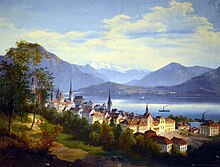
- Africa Museum
- Fisheries Museum
- Cantonal Museum of Prehistory
- Kunsthaus Zug
- Museum Burg Zug
Cinemas
There are three cinemas (Seehof, Gotthard, Lux) in the city of Zug .
Youth culture
- Association of Zug youth meeting points (zjt)
- industrie45 (coll. i45) - youth culture center Zug
- RadioIndustrie - youth radio in the i45
- Youth animation Zug (jaz)
- Electroplating - cultural center
- podium41 (formerly Chaotikum) - youthful stain
- regarding youth and children - Zug specialist office
- Children's and youth theater, Zug: theater projects with children, teenagers and young adults
School social work is a specific social service in the school building.
Library
The Zug library is the general public library of the city of Zug as well as the study and educational library for the city and canton of Zug. It has a mandate to collect publications from and about Zug (Tugiensia) and also provides a broad and up-to-date collection of media for all age groups.
regional customs
The city of Zug is rich in diverse and lived customs
- Agatha bread
- Old town market
- Bäckermöhli (Wednesday before St. Agatha, February 5th)
- Chesslete
- Chriesigloggä / Chriesisturm (mid / end of June, Monday at 12 noon)
- Chriesimärt (mid-end of June / July, Monday to Friday, 3 to 6 p.m.)
- Chröpfelimee (Old Carnival Sunday, Sunday after Ash Wednesday)
- Frauenthaler gingerbread
- Peace bell
- Corpus Christi
- Greth Schell (Güdelmontag, Carnival Monday)
- Michael’s Day
- Märlisunntig (Second Advent Sunday)
- Palm ties
- Räbeliechtliumzug
- Zugerberg ski run
- Carol singing
- Bull market (first Wednesday / Thursday in September)
- Pilgrimage Einsiedeln
- Zug red chalk
Festivals
| festival | Type / subject | since | month | proof |
|---|---|---|---|---|
| a lot of jazz | jazz | 1996 | April | [1] |
| Enjoyment Film Festival | Cinema & cuisine | 2015 | May | [2] |
| Boardstock | Sports | 2001 | July | [3] |
| Jazz Night train | jazz | 1992 | August | [4] |
| Rock the docks | Open air festival | 2008 | August September | [5] |
| Accordion Festival Zug | accordion | 2007 | September | [6] |
| ABRAXAS | Children's and young people's literature | 2002 | November, every two years | [7] |
Art in public space
| Authorship | Surname | Place / form | year |
|---|---|---|---|
| Severin Märki | Göggel | 5-part sculpture group | 2000 |
| Markus Kummer | Bordure - 4 boulders | Schützenmatt gravel pit | 2017 |
| Pavel Pepperstein | Wall painting on the prison wall | 2002 | |
| Ilya and Emilia Kabakov | Drinking fountain | 2003 | |
| James Turrell | Light transport | train station train | 2003 |
| Quido Sen | Air duct | facade | 1992 |
| Rudolf Blättler | Three women and large women | Sculptures | 1986 |
| Matt Mullican | Model of a cosmology | plastic | 1996 |
| Anton Egloff | Hear East South West North | plastic | 1995 |
| Carmen Perrin | Mémoire d'une strate 1887-1996 | plastic | 1995 |
| Maria Bettina Cogliatti | Trompe-l'oeil | Disaster Bay | 1998 |
| Romano Galizia | Pair of swans | plastic | 1964 |
| Martin Chramosta | Friends wanted 'Shorty' | Suburban quay | 2018 |
| Roman Signer | Lake view | Suburban quay | 2015 |
| Josef Staub | Big Rugel | Polished sheet steel plastic | 1997 |
| Tadashi Kawamata | Work in progress, round benches | Arena, wooden installation | 1997 |
| Hans Potthof | Arcade painting | Customs house hall | 1986 |
| Markus watch | untitled | Neon installation Burgbachschulhaus | 2012 |
| Fritz Wotruba | Large lying figure | Burgwiese, plastic | 1960 |
| Heinz Gappmayr | it will | Wall installation Kunsthaus Zug | 1996 |
| Richard Tuttle | Replace the Abstract Picture Plane ll | Garden art house, metal sculpture | 1997 |
| Markus watch | AND | New installation of the Zug library | 2015 |
| Johanna Näf | Lotus pond and space design | 1989 | |
| Walter Fähndrich | Tramonto | Sound installation during an astronomical sunset | 2008 |
| Henry Moore | Large Standing Figure: Knife Edge | 1976 | |
| Esther Stocker | 22 elements | Baarerstrasse 84 | 2009 |
| Vreni Spieser | Chrome flying carpet | Ahornstrasse 2-8 | 2015 |
| Luca Degunda | Wall painting No. 1 | Electroplating Zug, Chollerstrasse 173 | 2011 |
Town twinning
-
 Fürstenfeld , Austria , since 1986
Fürstenfeld , Austria , since 1986
The partnership with Fürstenfeld in Styria came about through the help from Zug to Fürstenfeld after the war.
-
 Kalesija , Bosnia-Herzegovina , since 2008
Kalesija , Bosnia-Herzegovina , since 2008
The partnership with Kalesija is due to the fact that about 1,000 residents of Zug come from this city; they had come to Switzerland as workers in the 1970s and 1980s and some of their families had brought their families to join them during the Bosnian War in the 1990s.
Personalities
- Werner Steiner the Younger (1492–1543), reformer in Zurich
- Joseph Müller (1659–1711 / 22), city physician in Zug and member of the “Leopoldina” academy of scholars
- Beat Heinrich Josef Zurlauben (1663–1706), captain and brigadier in French service
- Gerold Brandenberg (1733–1818), Abbey Librarian of St. Gallen
- Elise Ruepp (1790–1873), pioneer of girls' education
- Joseph Spillmann (1842–1905), Jesuit and writer
- Clemens Hess (1850–1918), teacher, physicist and meteorologist
- Johann Michael Bossard (1874–1950), artist
- Claudio Caroni (1907–1984), Head of the Altenrhein Aircraft and Vehicle Works (FFA)
- Casimir Huber (1915–1974), politician
- Leo Hafner (1924–2015), architect
- Hans Huber (1927–2018), entrepreneur
- Walo Lüönd (1927–2012), actor
- Walter Haettenschweiler (1933–2014), graphic designer
- Werner Hofmann (1935–2005), graphic artist
- Erwin Bischof (1940–2015), management consultant, politician and publicist
- Christine Kamm-Kyburz (1949–2019), art historian
- Thomas Hürlimann (* 1950), writer
- Hugo Helfenstein (* 1953), musician
- Christoph Kühn (* 1955), film director
- Roberto Bossard (* 1959), jazz musician
- Ursula Keller (* 1959), physicist
- Simonetta Sommaruga (* 1960), Federal Councilor
- Carlo Meier (* 1961), writer
- Andreas Kleeb (* 1962), cattle dealer, entrepreneur and politician
- Sandro Bertaggia (* 1964), former ice hockey player
- Bruno Blume (* 1972), writer and publisher
- Markus Egger (* 1975), beach volleyball player
- Patrick Fischer (* 1975), former ice hockey player
- Alex Huber (* 1982), jazz musician
- Michael Elsener (* 1985), cabaret artist
- Daniel Henggeler (* 1988), racing cyclist
- Maurus Twerenbold (* 1988), jazz musician
- Nicolas Raemy (* 1992), handball player
literature
General
- Directorate for Education and Culture of the Canton of Zug (Ed.): ZG - Ein Heimatbuch. Balmer Verlag, Zug 1999, ISBN 3-85548-052-4 .
- Sibylle Omlin, Christian Raschle, Sonja Stauffer, Josef Wüest: Zug - city and canton. Balmer Verlag, Zug 2002, ISBN 3-85548-048-6 .
history
- Eugen Gruber: History of the Canton of Zug. Francke, Bern 1968.
- Eugen Gruber: Basic questions of Zuger history. Dossenbach printing house, Baar 1952.
- Eugen Gruber: Historical facts from the medieval records and documents from the city and country of Zug. Zürcher, Zug 1951.
- Peter Hoppe: Zug (community). In: Historical Lexicon of Switzerland .
Building history
- Linus Birchler : The art monuments of the Canton of Zug, 2nd half volume: The art monuments of Zug-Stadt, with addendum 1935–1959. (= Swiss art monuments. Volume 6). Edited by the Society for Swiss Art History GSK. Birkhäuser Verlag, Basel 1959. DNB 811066673 .
- Adriano Boschetti-Maradi, The expansion of Zug in 1478. A renaissance urban development achievement. In: Georges Bloch Yearbook of the Art History Institute of the University of Zurich 11/12, 2004/05, 60–75.
- Adriano Boschetti-Maradi et al., The expansion of Zug's city fortifications under Habsburg rule. In: Tugium 23/2007, 105-136.
- Josef Grünenfelder: St. Oswald's Church in Zug. Society for Swiss Art History, Bern 1998, ISBN 3-85782-622-3 .
- Josef Grünenfelder et al .: Zug Castle: Archeology - Building History - Restoration. Cantonal archeology / Swiss Castle Association, Zug / Basel 2003 (Swiss contributions to the cultural history and archeology of the Middle Ages, vol. 28), ISBN 3-908182-12-3 .
- Christine Kamm-Kyburz: The Reformed Church and Church Center in Zug. Swiss Art Guide Series 97, No. 963, published by the Society for Swiss Art History , Bern 2015.
Web links
- Official website of the city of Zug
- Illustration of the city 1572 in Civitates orbis terrarum by Georg Braun and Frans Hogenberg
- Zug (city) on the ETHorama platform
Individual evidence
- ↑ Permanent and non-permanent resident population by year, canton, district, municipality, population type and gender (permanent resident population). In: bfs. admin.ch . Federal Statistical Office (FSO), August 31, 2019, accessed on December 22, 2019 .
- ↑ a b Permanent resident population by nationality, gender and municipality ( Memento from January 1, 2015 in the Internet Archive ) (permanent resident population)
- ↑ a b Beat Dittli: Zug place names. Lexicon of names of settlements, fields and bodies of water in the canton of Zug. Localization, Interpretation, Stories, Volume 5, Zug 2007, pp. 308-310; according to this Lexicon of Swiss Community Names , ed. from the Center de Dialectologie at the University of Neuchâtel under the direction of Andres Kristol, Frauenfeld / Lausanne 2005, p. 990 f.
- ↑ Schweizerisches Idiotikon , Volume XVII, Column 461, Zug I 6b .
- ↑ Thomas Brunner: Migration & Identity , in: ZG - Ein Heimatbuch , p. 221.
- ^ Josef Grünenfelder, Toni Hofmann and Peter Lehmann: The castle of Zug. Archeology - Building History - Restoration. Swiss contributions to the cultural history and archeology of the Middle Ages 28, Zug / Basel 2003.
- ↑ Thomas Glauser: Sust and customs in the late medieval city of Zug. P. 93. In: Tugium. 16/2000. Kündig Druck, pp. 79–96, ISBN 3-907587-16-2
- ^ Adriano Boschetti-Maradi, Toni Hofmann and Peter Holzer: The expansion of the Zug city fortifications under Habsburg rule. In: Tugium 23/2007, 105-136.
- ↑ Thomas Glauser: 1352 - Zug does not become federal. In: Tugium. 18/2002. Kündig Druck, pp. 103–115, ISBN 3-907587-18-9
- ^ Adriano Boschetti-Maradi: The expansion of Zug in 1478. An urban development of the Renaissance. In: Georges Bloch Yearbook of the Art History Institute of the University of Zurich 11/12, 2004/05, 60–75.
- ↑ Perrin, Carmen: Mémoire d'une strate 1887–1996 (1995) at www.stadtzug.ch, accessed on February 12, 2017.
- ^ City of Zug (ed.): The Zug suburbs. Commemorative publication on the 100th anniversary of the suburban disaster of July 5, 1887. Kalt-Zehnder-Druck, Zug 1987. ISBN 3-85761-234-7 .
- ^ Zug Online: History. Retrieved March 26, 2009 .
- ↑ Religious affiliation according to large cities. Retrieved June 21, 2020 .
- ↑ Federal Statistical Office (ed.): Eidgenössische Volksensus 2000 - Population development of the municipalities 1850–2000 ( Memento of March 14, 2016 in the Internet Archive ). Federal Statistical Office, Neuchâtel 2002, ISBN 3-303-01154-0
- ^ Minutes of the election results. (PDF) Retrieved October 7, 2018 .
- ↑ Parliament train. (PDF) Retrieved October 3, 2010 .
- ↑ Parliament train. (PDF) Retrieved October 3, 2010 .
- ↑ City Council. Retrieved May 7, 2016 .
- ↑ Official Gazette of the Canton of Zug , No. 41, October 12, 2018, p. 4421.
- ^ Federal Statistical Office : NR - Results parties (municipalities) (INT1). In: Federal Elections 2019 | opendata.swiss. August 8, 2019, accessed August 1, 2020 .
- ^ Thomas Brunner: The town hall in Zug. (Swiss Art Guide, No. 854/855, Series 86). Ed. Society for Swiss Art History GSK. Bern 2009, ISBN 978-3-85782-854-6 .
- ↑ B. Staub: The Canton of Zug, 1869, p. 53
- ↑ Hans Georg Wehrens: The dance of death in the Alemannic language area. «I have to do it - and don't know what» . Schnell & Steiner, Regensburg 2012, ISBN 978-3-7954-2563-0 . P. 44 f.
- ^ Laetitia Zenklusen and Josef Grünenfelder: Parish Church of Brother Klaus and Chapel of St. Nicholas in Oberwil. (= Swiss Art Guide, Volume 720, Series 72). Edited by the Society for Swiss Art History GSK. Bern 2002, ISBN 3-85782-720-3 .
- ↑ Ueli Kleeb, Caroline Lötscher (ed.): Chriesi: Cherry culture around Zugersee and Rigi. Edition Victor Hotz, Zug 2017.
- ↑ Art doesn't have to be comfortable - Zug culture. Retrieved April 6, 2019 .
- ↑ Kalt Medien AG: Zug ... encore Das Theater im Burbachkeller. Edition 1000th train, ISBN 978-3-85761-323-4 .
- ^ Homepage of Zug Castle. Retrieved February 25, 2011 .
- ^ The cinemas in Zug
- ↑ City of Zug customs on stadtzug.ch/
- ↑ City Guide Zug 2020
- ↑ Zug Online: Fürstenfeld - the sister city of Zug
- ↑ Zug Online: Kalesija (Bosnia-Herzegovina)
- ^ Pablo Crivelli: Claudio Caroni. In: Historical Lexicon of Switzerland . August 27, 2003 , accessed March 30, 2020 .
